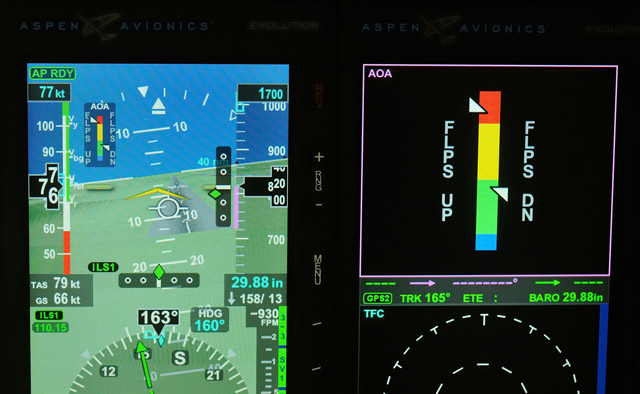
Approaching the runway, Aspen displays show adequate margin above stall with flaps down—but not with flaps up.
Software upgrade for Evolution displays
Because Aspen Avionics’ new Evolution Angle of Attack (AOA) Indicator calculates angle of attack from flight envelope data received from the air data computer and attitude heading reference system (AHRS) incorporated in the Evolution 1000 PFD or Evolution 1000 MFD, and a certified GPS, it does not require additional hardware, sensors, or external aircraft modifications. That makes adding AOA to an Aspen Evolution display a simple software update.
“The FAA is aggressively promoting the use of AOA-based systems to reduce general aviation accidents caused by loss of control,” said Perri Coyne, Aspen’s director of marketing operations. “We are offering a software-based derived angle of attack function that provides real-time stall margin awareness without hardware, cabling, or aircraft modifications.” The software upgrade requires only a short calibration flight, she added.
Aspen says the system improves safety by providing real-time flaps-up and flaps-down stall margin awareness, enabling the pilot to visualize the available lift before changing aircraft configuration—especially crucial during a go-around. An intuitive display provides an immediate, clear visual depiction of trend toward stall and stall margin. AOA is displayed prominently on the Aspen PFD or MFD.
“It’s a very different AOA product that what you’ve seen in the industry lately,” said John Uczekaj, Aspen’s president. “We believe very strongly that AOA has a major impact on preventing loss-of-control accidents,” he added, explaining that the company has spent a lot of time looking at current AOA products, whether displayed in the panel or on the glareshield. “It’s very hard to integrate those instruments into your normal scan, especially when you’re stressed. At this point, AOA hasn’t become an integral part of our environment. We’re thinking about making AOA a standard function on all our PFDs.”
In July, Aspen’s base of more than 9.000 installed systems—as well as new customers—can have AOA. “AOA will become an integral part of their flying,” said Uczekaj, who thinks other avionics manufacturers will add AOA—something he’d like to see. “We want to make AOA an integral part of our flying experience, increasing the safety of GA,” he said. “We believe strongly in this.” More widespread availability of AOA capabilities also will force AOA into the training curriculum, he noted.
Uczekaj said he has heard flight instructors say they don’t know how to train pilots to properly interpret AOA information. “I didn’t really understand it until I started using it in everyday flying,” he added. “I didn’t understand it from a pilot’s perspective—I understood it intellectually.”
In a demonstration flight with James Buck, Aspen’s director of flight operations, the AOA indicator was shown prominently on the left side of the PFD, just to the right of the speed tape. An arrow on the left shows the stall margin with the airplane in a clean configuration, and one on the right shows the margin with flaps down. It’s intuitive and easy to understand (if you’re flying with partial flaps, you’ll have to interpolate the stall margin). After takeoff, as airspeed increases well beyond the stall speed, the AOA indicator disappears from the PFD—only to reappear as airspeed slows.
In an airplane with an Aspen multifunction display, the pilot has a choice of several sizes and positions at which AOA can be displayed; the information remains on display unless the pilot selects other data. Initially I preferred a large display, taking about half of an Evolution MFD screen, but I quickly became comfortable with a much smaller, thumbnail depiction that easily caught my eye while scanning the Cirrus SR22’s panel.
I found AOA information especially valuable during a go-around; climbing with full power, the stall margin with flaps extended was in the green, near the yellow caution zone—but with flaps up, it would be well into the red. Easy decision—don’t reach for the flap handle just yet!
“We don’t want customers to get comfortable flying in the yellow,” Buck said. “If it’s in the yellow, you need to do something to get out of the yellow.” He prefers to view the AOA indication in the MFD’s top right thumbnail. “I find that’s what works for me, because it catches in my scan.”
The calibration flight requires flying four timed segments, at two airspeeds in clean and dirty configurations. Buck recommends doing the flight with your Aspen dealer—and in calm air. Aspen has been working on the derived AOA for two years, and did 90 hours of flight test in March alone, using the Cirrus and a Piper Lance. “It’s been a long-term effort,” he said.
Uczekaj said the Evolution AOA Indicator is the first product resulting from Aspen’s partnership with Centro Italiano Ricerche Aerospaziali (CIRA), which operates an aeronautical research facility in Capua, Italy. CIRA was created in 1984 to manage Italy’s aerospace research program. “We have a lot of other ones brewing here. We’re very excited about that relationship,” he said.
The company said its Evolution AOA will be available in July 2015. It is priced at $1,995. For more information, see the website.
Email [email protected]


